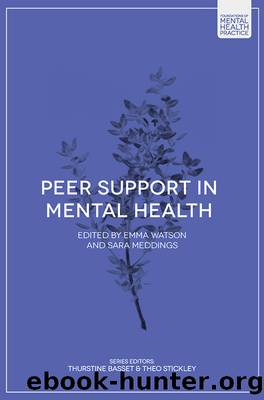Peer Support in Mental Health by Emma Watson Sara Meddings

Author:Emma Watson, Sara Meddings [Emma Watson, Sara Meddings]
Language: eng
Format: epub
ISBN: 9781352005066
Barnesnoble:
Publisher: Bloomsbury Academic
Published: 2019-02-20T00:00:00+00:00
Introduction
This chapter explores carers supporting other carers to progress their own recovery. It raises the question âwho is a peer?â, with specific emphasis on including family and friends as peers.
It includes reflections on the development of peer support from carers support groups through to paid peer support roles. Other roles for carers, such as peer trainers, are mentioned to illustrate a range of involvement opportunities, although these do not offer the full mutuality and reciprocity of peer support.
Language
The word âcarerâ
Although âcarerâ is the official term used in UK services and policies for people who support their family and friends, the term itself can lead to confusion. Colloquially, in the media, and in some official documents, âcarerâ is also used to describe the paid care workers who provide vital support in the community for people who need additional help with daily tasks, including personal care. Carersâ organisations, such as Carers UK and the Carers Trust, emphasise the difference between these paid workers and the family and friends who provide informal and unpaid support for their relative or friend. The government fact sheet for the Care Act (2014) defines a âcarerâ as:
someone who helps another person, usually a relative or friend, in their day-to-day life. This is not the same as someone who provides care professionally or through a voluntary organisation. (Department of Health, 2016)
There are mixed opinions about the term from both carers themselves and the people they support. It can infer a one-way relationship with one person giving care to the other, ignoring emotional, financial or social reciprocity. Both emotional distress and the associated caring role can feel invisible and hidden, adding another barrier to identifying carers, for the family themselves as well as for support services. Physical or personal care can be more readily witnessed than the emotional care and support for people experiencing distress. Additionally, young people may not recognise their own role as carers; parents may be reluctant to identify a young person as their only source of support; some languages do not have a direct translation of the word or concept of the role (Carers, 2011).
There are challenges associated with the residential and legal aspects of some mental health support. Family and friends of people in long-term care such as forensic (secure) mental health services may regard themselves as visitors rather than carers (Ridley et al., 2014), reinforced by some definitions which imply that carers must live with the person they support. Staff may be familiar with communicating with the nearest relative under mental health legislation, but this person is not always the primary carer.
However, while the word itself may involve these challenges, in the UK it is an identity that gives access to a range of carers services including carers centres, carers assessments and financial support such as carers allowance. If people do not identify, or are not identified, as carers they can be excluded from this vital support.
This chapter refers to the support network of family and friends who are not paid to be
Download
This site does not store any files on its server. We only index and link to content provided by other sites. Please contact the content providers to delete copyright contents if any and email us, we'll remove relevant links or contents immediately.
Cecilia; Or, Memoirs of an Heiress — Volume 1 by Fanny Burney(32446)
Cecilia; Or, Memoirs of an Heiress — Volume 2 by Fanny Burney(31875)
Cecilia; Or, Memoirs of an Heiress — Volume 3 by Fanny Burney(31861)
The Great Music City by Andrea Baker(31550)
We're Going to Need More Wine by Gabrielle Union(18976)
All the Missing Girls by Megan Miranda(15604)
Pimp by Iceberg Slim(14403)
Bombshells: Glamour Girls of a Lifetime by Sullivan Steve(13983)
Talking to Strangers by Malcolm Gladwell(13238)
Norse Mythology by Gaiman Neil(13221)
Fifty Shades Freed by E L James(13165)
For the Love of Europe by Rick Steves(13155)
Mindhunter: Inside the FBI's Elite Serial Crime Unit by John E. Douglas & Mark Olshaker(9215)
Crazy Rich Asians by Kevin Kwan(9177)
The Lost Art of Listening by Michael P. Nichols(7413)
Enlightenment Now: The Case for Reason, Science, Humanism, and Progress by Steven Pinker(7244)
The Four Agreements by Don Miguel Ruiz(6643)
Bad Blood by John Carreyrou(6560)
Weapons of Math Destruction by Cathy O'Neil(6156)
